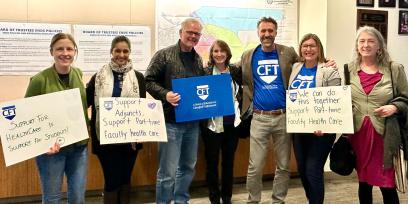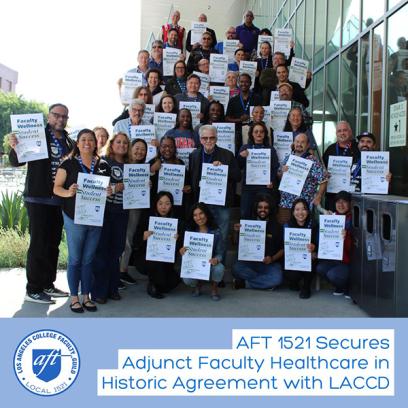This year, the California Federation of Teachers celebrated a historic win: state-funded healthcare benefits for part-time community college faculty. For educators who often struggle with low pay and inadequate benefits, scraping out a living by teaching at multiple campuses with little support, the new policy is a huge victory, and one that is likely to set a new precedent in the availability of benefits nationwide.
But while the money is set aside, there’s no guarantee that school administrators will distribute it as intended. That’s why union members have shifted their focus from statewide legislative advocacy to localized negotiating tables: AFT affiliates across the state are organizing their bargaining teams and coordinating efforts to make sure the state’s intentions go from numbers on a page to actual paid healthcare for those who need it.
So far, nine of the state’s 27 AFT affiliates, including the state’s three largest, have successfully contracted for healthcare benefits for their part-timers.
How it works
The CFT planned this ambitious effort in 2019, but the COVID-19 pandemic required a shift in strategic timelines. So in October 2021, members launched their legislative campaign, resulting in a dramatic leap in the 2022-23 state budget, from the drastically insufficient $490,000 set aside for part-time faculty healthcare benefits to a much more robust $200,490,000 annually.
That pot of money is distributed as reimbursements to districts to use to cover part-time faculty healthcare costs. But simply funding districts to provide possibly inadequate, inaccessible insurance options would fall short—so new legislation attaches strings to employers wanting to receive full state funding. These new guidelines require that districts meet each of the following four conditions to receive 100 percent reimbursement (instead of just 50 percent):
- Benefits must be offered to all part-time faculty with an assignment equal to or greater than 40 percent of a full-time assignment in their discipline.
- Benefits must be the same as those offered to full-time faculty.
- Premiums must be the same as those for full-time faculty.
- Multidistrict faculty whose total assignments are equal to or greater than 40 percent of a full-time assignment can buy insurance and be reimbursed directly. This would apply to the “freeway flyers” who cobble together a living by working at more than one campus, restricted by course limits for part-time staff.
The change was driven by thousands of letters from union faculty and allies to legislators and the governor, their testimony at legislative hearings, their quotes and op-eds in the media, social media postings and in-person conversations with lawmakers about the urgency of providing basic care to our educators at community colleges—the engines of education and economic mobility for a huge swath of Californians.
Their arguments were compelling.
Addressing an urgent need
Corrie Osuna, a fashion design professor and a member of the Los Angeles College Faculty Guild, hasn’t had health insurance for 15 years, despite a history of transient ischemic attacks, or TIAs—episodes that are sometimes called mini-strokes. She was disabled for 10 months and “lost everything,” she says: her car, her house and her ability to work. She couldn’t afford health insurance for both herself and her son, so she chose to insure her son, who was diagnosed with autism and needed special care.
Osuna is back on her feet now, though she still sometimes experiences fatigue and difficulty with word recollection. Her medical expenses are still daunting, so she had begun to apply for jobs outside of teaching, just so she could have health insurance. “I was devastated to think that I would have to leave,” she says; she loves her job and says helping her students discover their capabilities gives her “the greatest joy.”
Luckily, the new legislation and her union’s upcoming agreement has allowed her to stay. The prospect of healthcare benefits, she says, is “like a dream come true.”
Laila Dellapasqua, who teaches English as a second language at El Camino College, is also excited about the change. As her only healthcare benefit from work, she receives just $75 a semester from the college for medical costs. Not only does that fall far short of covering the premiums and deductibles, she said in an LA Progressive article, $75 is barely enough for a co-pay or medical prescription bill. “My family and I simply cannot afford the cost of quality healthcare. I have had to forgo needed appointments for my physical and mental health.” Laila and her fellow union members have been escalating mobilizations in her district for several months as they demand implementation of this new funding at their district’s negotiating table.
Before this policy change, a CFT survey showed that 44 percent of faculty surveyed put off needed healthcare; 63 percent postponed dental care. Forty-three percent didn’t see a doctor at all; others skipped medications or cut them in half to save money. That sacrifice affects not just educators, but students.
Hurting faculty, hurting students
“Time that should be dedicated to perfecting our craft and meeting with students is now overtaken by countless phone calls to insurance carriers and providers,” said Dellapasqua, describing her scramble for affordable healthcare coverage outside the community college system. Other faculty note that trying to reach a full-time course load in order to qualify for college benefits—always mindful of the possibility of class cancellations due to underenrollment—is a juggle as well. “It’s like a roller coaster that never stops,” Juli Jones, a history professor at Cuyamaca College, told CalMatters last year. “I’m always desperately trying to get more sections to feed this thing and keep it going.”
“Stable medical coverage for part-time instructors ensures quality, consistent instruction for our students,” says Dellapasqua. “Equity for part-time faculty equals equity for the students we serve.”
And that’s a lot of students: Part-time faculty are the majority of faculty at California community colleges, says English professor Linda Sneed, who works at Cosumnes River College in Sacramento. “Decreasing the stress and anxiety of part-time faculty who have to make serious sacrifices to be able to pay for healthcare for themselves and their families allows them to focus on maintaining their own and [their] families’ health and the learning and well-being of the students with whom they work.”
In addition to providing the budget for healthcare benefits, the new legislation focuses on increasing access to benefits, reducing costs for employees, ensuring that the benefits are high-quality and removing obstacles for faculty who teach in multiple districts—a reference to the “freeway flyers” who teach part time at multiple campuses to cobble together a living.
District by district
Securing these benefits is a top priority for the CFT, and to make sure it happens for every faculty member, the union held regional meetings and negotiations training sessions last fall. Hundreds of members attended to learn more about this newly available benefit—including many who had never engaged in union activities before.
In early April, the Los Angeles Community College District—the largest in the country—finalized an agreement that pushes the threshold for eligibility past the 40 percent mark designated by the state to 33 percent—meaning faculty who work 33 percent of a full-time schedule will be able to get these benefits. Fifteen hundred members will be eligible for the benefit.
“Part-timers are truly talented and hard-working, just as much as full-timers,” says Layal Lebdeh, who teaches astronomy and physics in the North Orange County Community College District. “Seeing other districts have moved forward and agreed with providing the full health coverage bill is truly inspiring to keep on going with our demands.”
[Virginia Myers]


